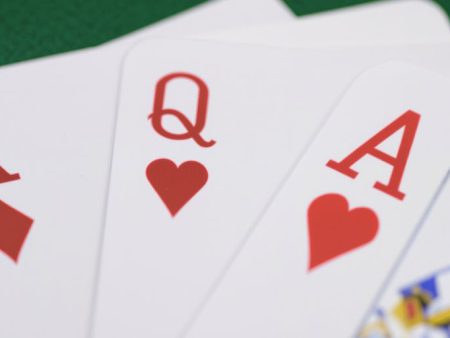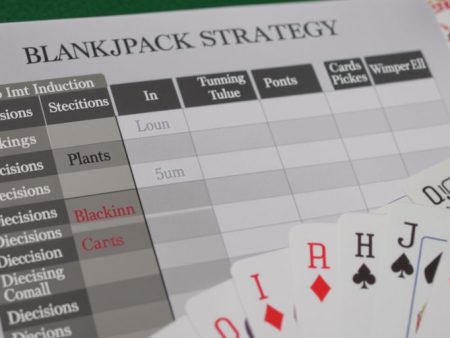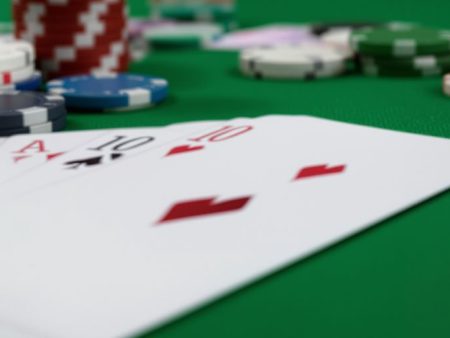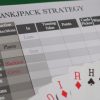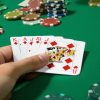So, you want to get better at blackjack? It’s a fun game, but knowing when to ask for another card, or when to just stick with what you’ve got, can be tricky. It’s not just about luck; there’s a smart way to play. This guide breaks down how to know when to hit or stand in blackjack, looking at your cards, the dealer’s card, and a few other things to help you make better choices at the table.
Key Takeaways
- Understanding how to know when to hit or stand in blackjack is about looking at your own hand total and the dealer’s visible card.
- Hard totals (hands without an ace counting as 11) have specific rules: generally, hit on 11 or less, stand on 17 or more, and be cautious with totals between 12 and 16.
- Soft hands, which include an ace that can be 1 or 11, offer more flexibility; you can often hit them more aggressively without busting.
- The dealer’s upcard is a major clue; weak upcards (2-6) mean the dealer might bust, so you might stand on weaker hands, while strong upcards (7-Ace) suggest you should hit more often.
- Basic strategy charts are your best friend for learning these decisions, and practicing with them, either online or with small bets live, is key to improving your game.
Understanding the Core Decisions: Hit or Stand
Alright, let’s talk about the absolute heart of playing blackjack: knowing when to ask for another card (hit) and when to be happy with what you’ve got (stand). It sounds simple, right? But honestly, this is where most people stumble. Get this wrong, and you’re basically just guessing, which is a fast track to losing your money. It’s not about gut feelings; it’s about math, plain and simple. We’re going to break down the core decisions you’ll face at the table.
The Fundamental Choice in Blackjack
Every single hand you play in blackjack boils down to this one question: hit or stand? You’ve got your two cards, the dealer shows one. Your goal is to get as close to 21 as possible without going over, and to beat the dealer’s hand. This decision isn’t random. It’s based on the cards you hold and the one card the dealer is showing. Making the right choice here, every time, is what separates a winning player from someone just hoping for luck.
When to Hit in Blackjack
So, when do you actually want another card? Generally, you hit when your hand total is low, meaning you have a good chance of improving your hand without busting. Think of it as a calculated risk. If you have a hand like 11 or less, you absolutely cannot bust by hitting, so it’s always the right move. Even with slightly higher totals, like 12, 13, or 14, hitting can be the smart play, especially if the dealer is showing a strong card. It’s all about giving yourself a better shot at a winning total.
When to Stand in Blackjack
Standing means you’re satisfied with your current hand and you don’t want any more cards. You stand when your hand total is high enough that hitting would likely cause you to bust (go over 21). Most of the time, this means having a total of 17 or higher. However, it’s not always that straightforward. Sometimes, even with a total like 12, 13, 14, 15, or 16, standing is the correct play if the dealer’s upcard is weak. If the dealer is showing a 2, 3, 4, 5, or 6, they’re more likely to bust, so you might want to stand on a lower total yourself to let them take the risk.
Decoding Your Hand: Hard Totals

Navigating Hands Without an Ace
So, you’ve got a hand without an ace, or maybe an ace that’s already acting as a 1. This is what we call a "hard total." It’s a bit more straightforward because there’s no flexibility with the ace’s value. You know exactly what you’ve got, and that makes decisions simpler, but also riskier. If you go over 21, you bust, and that’s that. No second chances here.
When to Hit on Hard Totals
Generally, you want to hit when your hard total is low. Think 11 or less. It’s almost impossible to bust with these totals, so grabbing another card is usually a good idea. Even with totals like 12, 13, 14, 15, or 16, you’re often better off hitting, especially if the dealer is showing a strong card (like a 7, 8, 9, 10, or Ace). Why? Because the dealer has a good chance of making a strong hand themselves, and your current total is likely not going to cut it. You’re trying to improve your hand without going over the limit.
Here’s a quick rundown:
- 11 or less: Always hit. You can’t bust.
- 12: Hit if the dealer shows 2 or 3. Stand if they show 4 through 6. Hit if they show 7 through Ace.
- 13-16: Stand if the dealer shows 2 through 6. Hit if they show 7 through Ace. This is where it gets tricky. You’re on the edge, and the dealer’s upcard really matters.
When to Stand on Hard Totals
When do you stand pat? It’s all about the dealer’s upcard and your own total. If your hard total is 17 or higher, you should always stand. The odds of busting if you hit are just too high. Even with totals like 13, 14, 15, or 16, if the dealer is showing a weak card (2 through 6), you stand. The logic is that the dealer is more likely to bust with those upcards. You’re playing the odds, trying to let the dealer make a mistake. It feels a bit passive, I know, but it’s often the smart play. You’re basically saying, "Okay, dealer, you go first, and let’s see if you can beat me without busting."
Mastering Soft Hands: The Ace Advantage

Alright, let’s talk about those hands with an Ace. They’re special, you know? Because an Ace can be an 11 or a 1, these hands are called ‘soft’. This flexibility is a huge deal in blackjack, giving you more options to improve your score without busting. It’s like having a secret weapon in your pocket. You gotta know how to use it right, though.
Understanding Soft Hands
A soft hand is any hand where at least one Ace is present, and it’s currently counting as 11. So, an Ace and a 6 is a soft 17. An Ace, a 3, and a 4 is also a soft 18. The key thing is that if you hit and get a card that would make the Ace’s value of 11 too high (over 21), it automatically becomes a 1. This means you can’t bust on your first hit with a soft hand. Pretty neat, huh?
Hitting with Soft Hands
So, when do you hit on these flexible hands? It really depends on what the dealer is showing. Generally, if you have a soft hand that totals 17 or less, you should hit. Why? Because the dealer might have a better hand, and you have a good chance of improving your score without busting. For example, with a soft 17 (Ace-6), hitting is usually the play. You might get a 3, making it a hard 10, or a 10, making it a hard 17. Either way, you’re in a better spot than a soft 17.
Standing with Soft Hands
Now, when do you stand? You stand on soft hands when you’ve got a decent total, and the dealer looks like they might be in trouble. A soft 19 (Ace-8) or soft 20 (Ace-9) are hands you’d almost always stand on. They’re pretty strong totals. Even a soft 18 (Ace-7) is a tricky one. You’ll stand against a dealer’s 2 through 8. But against a 9, 10, or Ace? You might want to hit that soft 18. It’s all about reading the dealer’s upcard and knowing when your soft hand is good enough to hold its ground. Don’t get too greedy with those Aces; sometimes, standing is the smartest move.
Reading the Dealer’s Upcard
The dealer’s upcard is like a peek into the dealer’s potential hand, and knowing how to read it is super important for making smart decisions. It’s not just about your hand; you’ve got to consider what the person running the game might have. This is where strategy charts come in handy, showing you the best move based on your hand and that single card the dealer shows.
The Dealer’s Weak Upcards
When the dealer shows a low card, like a 2, 3, 4, 5, or 6, these are generally considered weak upcards. Why? Because the dealer has a higher chance of busting. They have to hit until they reach at least 17, and with a low upcard, they’re more likely to draw cards that push them over 21. This is your opportunity! You can afford to be a bit more aggressive with your own hand, maybe even doubling down when you have a good starting point, because the dealer is more likely to go bust.
The Dealer’s Strong Upcards
On the flip side, when the dealer shows a 7, 8, 9, 10, or an Ace, these are strong upcards. The odds shift in the dealer’s favor here. They have a much better chance of making a strong hand, usually 17 or higher, without busting. With these cards, you need to play it safer. Standing on a decent total becomes more appealing, and you should be more cautious about hitting or doubling down. You don’t want to risk busting yourself when the dealer is already in a good position.
Dealer’s Upcard Influence on Your Decisions
So, how does this all tie together? It’s all about probabilities. A weak dealer upcard (2-6) means you should generally hit more often, stand on lower totals, and look for opportunities to double down. A strong dealer upcard (7-Ace) means you should stand more often, hit on lower totals, and be very careful about doubling or splitting. It’s a constant dance between your hand and the dealer’s visible card. For example, if you have a hard 12, you’d stand if the dealer shows a 4, 5, or 6, but you’d hit if they show a 2, 3, 7, 8, 9, 10, or Ace. It’s a bit of a puzzle, but once you get the hang of it, it makes a huge difference in your game. Seriously, it’s like night and day compared to just guessing!
Strategic Doubling Down Opportunities

Doubling down. It sounds so powerful, doesn’t it? And it is! This move is where you can really boost your winnings when the odds are in your favor. It’s not just about betting more; it’s about making a smart, calculated move to maximize your potential profit. Think of it as a calculated risk, a moment where you’re telling the dealer, ‘I like my chances, and I’m willing to put my money where my mouth is.’
When to Double Down
So, when exactly should you go for the double down? It’s not an everyday occurrence, but when the situation is right, you absolutely should. The general rule of thumb is to double down when you have a strong starting hand and the dealer is showing a weak upcard. This combination gives you a good shot at improving your hand with just one more card, and importantly, it puts the dealer in a position where they might bust.
Here are some prime opportunities:
- You have a hard 9: Double down if the dealer’s upcard is a 2 through 6. The dealer has a good chance of busting with these cards, and a 9 is a decent starting point for you.
- You have a hard 10: This is a fantastic spot. Double down against any dealer upcard from a 2 through a 9. You’re very likely to draw a 10-value card, giving you a total of 20.
- You have a hard 11: This is arguably the best doubling situation. You should double down against any dealer upcard from a 2 through a 10. Drawing a 10-value card here gives you a powerful 21.
- Soft hands: These are also great candidates for doubling. We’ll get into the specifics of soft hands later, but generally, if you have an Ace and a favorable card, doubling can be very profitable.
Maximizing Your Bet with Doubling
Doubling down is all about seizing opportunities. It’s not just about doubling your bet; it’s about doubling your potential winnings on a single hand. When you double down, you’re committing to taking only one more card. This is why it’s so important to only do it when you have a strong starting hand and the dealer is weak. You’re essentially saying, ‘This is my best shot, and I want to capitalize on it.’ It’s a thrilling part of the game when you get it right!
Specific Doubling Scenarios
Let’s break down a few more specific scenarios where doubling down is your best friend:
- Hard 9 vs. Dealer 2-6: As mentioned, this is a solid play. You’re hoping to draw a 7, 8, 9, or 10 to make a strong total.
- Hard 10 vs. Dealer 2-9: You’re practically salivating here. Drawing any card from 2 to 10 gives you a total of 12 to 20, with 10s and Aces being the dream cards.
- Hard 11 vs. Dealer 2-10: This is the golden ticket. You’re almost guaranteed to get a 10-value card, giving you 21. It’s a beautiful thing.
Remember, the key is to always consult basic strategy charts. They’re your roadmap to making these decisions correctly. Don’t just guess; know the math behind it. It’s what separates a casual player from someone who’s really trying to win.
The Art of Splitting Pairs
Splitting pairs in blackjack is where things get really interesting, and honestly, a bit tricky. It’s not just about having two of the same card; it’s about knowing when that pair is actually a golden ticket to a better hand, or when it’s just a trap. You see, when you split, you’re essentially turning one hand into two, each starting with one of the cards from your original pair. This opens up a whole new world of possibilities, but you gotta play it smart.
When Splitting is Advantageous
Splitting is advantageous when it gives you a better chance to win against the dealer’s upcard. Think of it as breaking down a potentially weak hand into two stronger ones. For example, a pair of Aces is almost always a split. Why? Because two Aces give you two chances at getting a blackjack or a very strong 21. On the flip side, a pair of 10s (like a King and a 10) is usually a standing 20, which is a fantastic hand. Splitting those 10s would give you two hands starting with 10, which are much weaker than that solid 20.
Pairs to Always Split
There are certain pairs you should always, without question, split. These are the no-brainers, the hands that basic strategy screams at you to break apart.
- Aces: Always split Aces. You get two chances at a natural 21, or at least two strong starting hands.
- Eights: Always split Eights. Two Eights give you a total of 16, which is a terrible hand to hit. Splitting them gives you two hands starting with an 8, which are much more playable.
Pairs to Never Split
Then there are the pairs that you should absolutely keep together. Splitting these is usually a losing proposition.
- Tens (and face cards): Never split Tens, Jacks, Queens, or Kings. You already have a 20, which is a very strong hand. Splitting them would likely lead to weaker hands.
- Fives: Never split Fives. A pair of Fives gives you a total of 10. This is a perfect hand to double down on, not split. Splitting them gives you two hands starting with a 5, which are not as good as doubling your 10.
Advanced Considerations for Hit or Stand
Sometimes, the standard hit or stand advice needs a little tweaking. It’s not always as simple as just looking at your hand and the dealer’s upcard. There are other things to think about, like the rules of the specific game you’re playing and whether you have the option to surrender. These can really change what the best move is.
Surrender Strategy
Surrendering might sound like giving up, and in a way, it is. But it’s a smart move when the odds are really stacked against you. If you have a terrible hand, say a hard 16, and the dealer is showing a strong card like a 9, 10, or Ace, surrendering can save you money. You give up half your bet, but you avoid losing the whole thing. It’s a calculated risk to cut your losses.
Impact of Different Game Rules
Not all blackjack games are created equal. The rules can change how you should play. For instance, some games let the dealer hit on a soft 17 (an Ace and a 6), while others make them stand. If the dealer hits on soft 17, it means they have a slightly better chance of improving their hand, so you might want to be a bit more aggressive with your own hitting or standing decisions. Also, some games only allow you to double down on specific totals, like 10 or 11. This restriction means you can’t always take advantage of a good doubling opportunity.
Deviations from Basic Strategy
Basic strategy is a fantastic starting point, but it’s not the be-all and end-all. If you’re playing a game with unusual rules or if you’re keeping track of the cards yourself (card counting), you’ll need to make adjustments. For example, if you know there are a lot of low cards left in the shoe, you might stand on a hand where basic strategy says to hit. These deviations are what separate good players from great ones. It takes practice and a good memory, but it can make a big difference in your winnings.
Avoiding Common Pitfalls
The Danger of Insurance Bets
So, you’re at the blackjack table, feeling pretty good about your hand. Then, the dealer flips over that Ace, and suddenly, this little voice whispers, "Insurance is a good bet." Don’t listen to it! Insurance is basically a side bet that the dealer has a blackjack. While it might seem like a smart move to protect your hand, statistically, it’s a losing proposition over the long haul. Think of it as paying extra for a safety net that rarely gets used. Most of the time, you’re just throwing money away. It’s tempting, I know, especially when you’ve got a nice stack of chips in front of you, but trust me, avoid it like a bad hand.
Understanding Even Money Offers
This one’s a bit like insurance, but it’s offered when you have a blackjack and the dealer shows an Ace. They’ll offer you "even money," meaning you get paid 1:1 on your bet instead of the usual 3:2. Again, this sounds safe, right? You lock in a win. But here’s the kicker: you’re giving up the chance to win even more if the dealer doesn’t have a blackjack. If you stand on the even money offer, you’re essentially playing out your blackjack against the dealer’s Ace, which is a strong position for you. It’s a classic case of choosing a small, guaranteed win over a potentially larger one. It feels secure, but it’s not the optimal play if you want to maximize your winnings.
The Myth of Other Players’ Actions
Ever been at a table where everyone else is hitting on a 16 against a dealer’s 10, and you’re just sitting there with your 12 against a 3, thinking, "Should I do what they’re doing?" Stop that right now. What other players do has absolutely zero bearing on what you should do. Their decisions are their own, and frankly, they might be terrible decisions. Blackjack strategy is all about your hand and the dealer’s upcard. Don’t get swayed by the crowd. It’s easy to feel pressure or get confused when everyone else seems to be on a different page, but stick to the math. Your goal is to play your best game, not to blend in. Seriously, just focus on your own cards. It’s your money on the line, after all.
Putting Strategy into Practice

So, you’ve spent time poring over those charts, memorizing the dance between your hand and the dealer’s peek. That’s awesome! But now what? It’s time to actually do it. Think of it like learning to ride a bike. You can read all about it, watch videos, but until you get on and pedal, you’re just dreaming. Blackjack strategy is the same way. You gotta put it into action.
Using Blackjack Strategy Charts
Look, nobody expects you to have every single scenario memorized overnight. That’s what the charts are for! Many casinos are cool with you having a small strategy card at the table. It’s not cheating, it’s just smart. Keep it handy, but try not to be that person who’s constantly buried in it, making everyone else wait. A quick glance is fine. The goal is to internalize this stuff so you don’t even need the chart. It’s like knowing song lyrics without looking at the sheet music. You want to get to a point where you see your cards and the dealer’s card, and the right play just pops into your head. It takes repetition, sure, but it’s totally doable.
The Importance of Practice
This is where the real magic happens. You can’t just read about hitting a 16 against a dealer’s 10 and expect to nail it every time at the table. You need to practice. A lot. Think about it: if a musician misses one note in every hundred, people notice. You don’t want to be that blackjack player. The best way to get good is to drill it. Play hands at home, use online simulators, whatever works. The idea is to get so familiar with the basic strategy that it becomes second nature. You should be making fewer mistakes in a real game than you do when you’re just chilling at home. If you’re still messing up basic strategy, take a break and come back to it. It’s a marathon, not a sprint. You’ll get there.
Transitioning to Live Play
Okay, so you’re feeling pretty good about the charts and you’ve practiced. Now comes the moment of truth: the actual casino. It’s different, right? There’s noise, other people, maybe a bit of pressure. Don’t let that throw you. Remember your practice. If the strategy says to double down, and you’re not allowed to double on that specific hand in that casino, just hit instead (unless it’s a soft 18, then stand). If you’re not sure about a rule, like whether the dealer hits or stands on a soft 17, just ask the dealer before you start playing. They’re usually happy to tell you. The biggest thing is to stay calm and stick to your plan. You’ve done the work, now go play some blackjack!
The Mathematical Basis of Decisions
Probability and Blackjack
Blackjack isn’t just about luck; it’s heavily influenced by math. Every decision you make, from hitting to standing, is based on probabilities. Think of it like this: each card has a certain chance of appearing next. The dealer’s upcard gives you a clue about their potential hand, and your own cards tell you your current standing. Understanding these odds is the bedrock of smart play. It’s not about guessing; it’s about making the statistically best move given the information you have. The goal is to increase your chances of winning and, just as importantly, to reduce the house’s advantage over time. It’s a constant dance with probability, trying to stay one step ahead.
Minimizing the House Edge
The house edge is that built-in advantage the casino has. It’s usually small in blackjack, but it’s there. Basic strategy is designed to shrink this edge as much as possible. By following a set of rules derived from millions of simulated hands, you play each situation in the way that loses the least amount of money in the long run. It won’t make you win every hand, but it dramatically improves your odds compared to playing on instinct alone. It’s about playing smarter, not harder, to keep more of your money at the table.
Computer Simulations and Basic Strategy
Where does this
Putting It All Together
So, knowing when to hit or stand in blackjack isn’t just guesswork. It’s about using a strategy, plain and simple. We’ve gone over the basics, like when to stand on those tricky 12-16 hands against a dealer’s weak card, and when to hit when the dealer shows something strong. Remember, practice is key. Whether you’re at a real table or playing online, sticking to these guidelines will help you make better choices. It won’t guarantee a win every time, but it definitely improves your odds and makes the game more enjoyable. Keep practicing, stay sharp, and you’ll be making smarter decisions at the blackjack table before you know it.
Frequently Asked Questions
When should I hit or stand in blackjack?
Think of your hand’s total. If it’s low, like 11 or less, you’ll probably want to hit to get closer to 21. If your hand is higher, say 17 or more, it’s usually safer to stand. For totals between 12 and 16, it gets a bit trickier and depends on what the dealer is showing.
How do I know when to hit or stand with a ‘hard’ hand?
A ‘hard’ hand is one without an Ace that can be counted as 11. For example, a 10 and a 7 makes a hard 17. With these hands, you play them as they are. If you have a hard total of 11 or less, always hit. If you have 12 to 16, you usually stand if the dealer shows a weak card (2-6) and hit if they show a strong card (7-Ace).
What’s a ‘soft’ hand, and how does it affect my decisions?
A ‘soft’ hand has an Ace that can be counted as either 1 or 11. For instance, an Ace and a 6 is a soft 17. These hands are great because you can’t bust by hitting! Generally, you can be more aggressive with soft hands, often hitting or doubling down, especially against weaker dealer cards.
How does the dealer’s upcard change my strategy?
The dealer’s visible card, called the ‘upcard,’ is super important. If the dealer shows a 2 through 6, these are considered ‘weak’ upcards because the dealer has a higher chance of busting. If they show a 7 through Ace, these are ‘strong’ upcards, meaning they’re more likely to make a good hand.
When is the best time to ‘double down’?
Doubling down means you double your bet and get just one more card. It’s a powerful move when you have a strong starting hand, like a total of 11, and the dealer has a weak card. You’re basically saying you’re confident that one more card will give you a winning hand.
Which pairs should I always split in blackjack?
Splitting pairs means if you get two cards of the same number (like two 8s), you can split them into two separate hands. You should always split Aces and 8s. Splitting Aces gives you two chances for a great hand, and splitting 8s helps you avoid a weak total of 16.
Should I ever take the ‘insurance’ bet?
Insurance is a side bet you can make if the dealer’s upcard is an Ace. It pays out if the dealer has blackjack. However, it’s generally a bad bet because, over time, you’ll lose more than you win. It’s best to skip it and focus on your main hand.
What is ‘basic strategy’ and why is it important?
Basic strategy is a set of rules based on math that tells you the best move (hit, stand, double, split) for every possible hand combination you can have against every possible dealer upcard. Using it significantly lowers the house’s advantage, making you a much better player.
